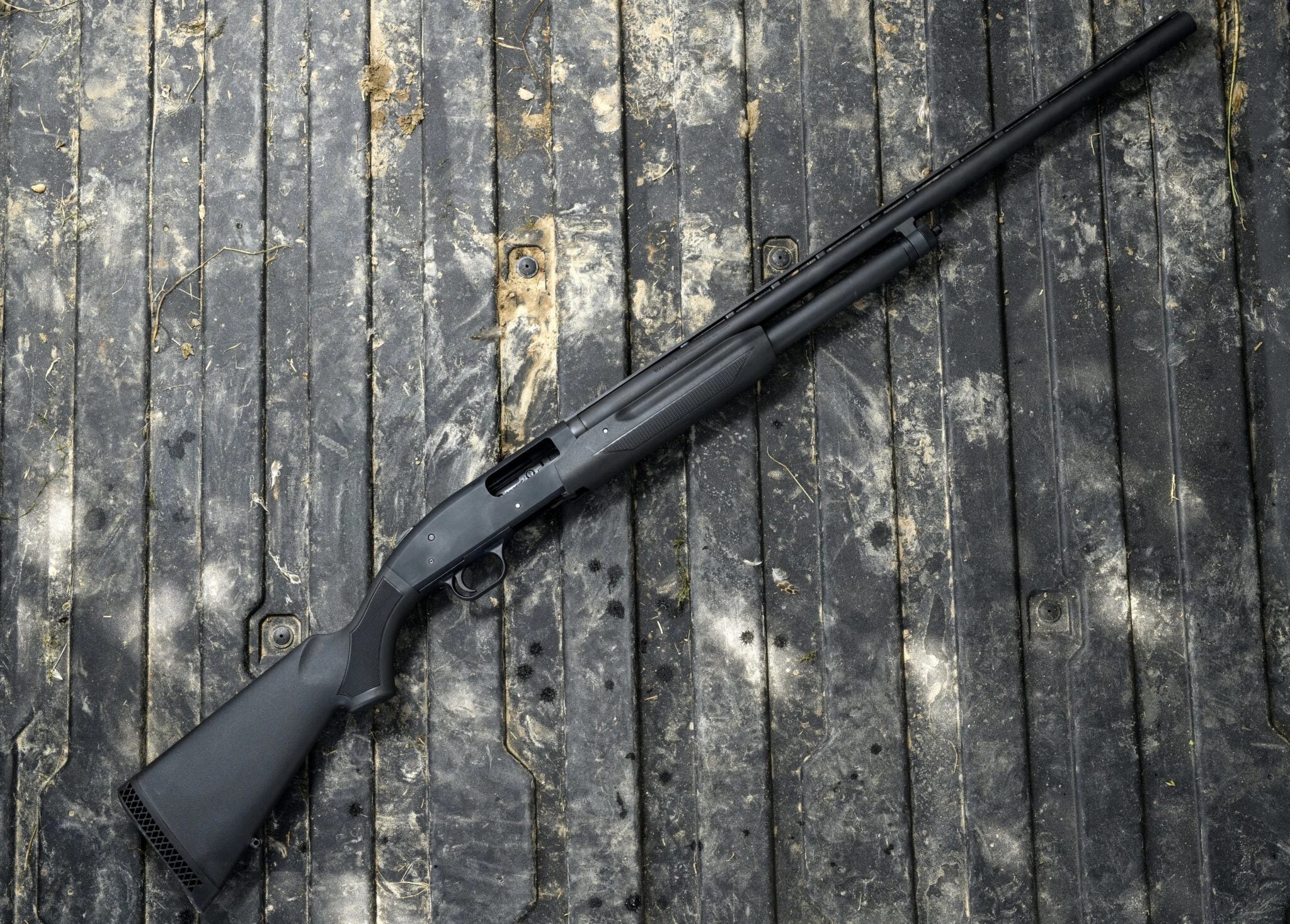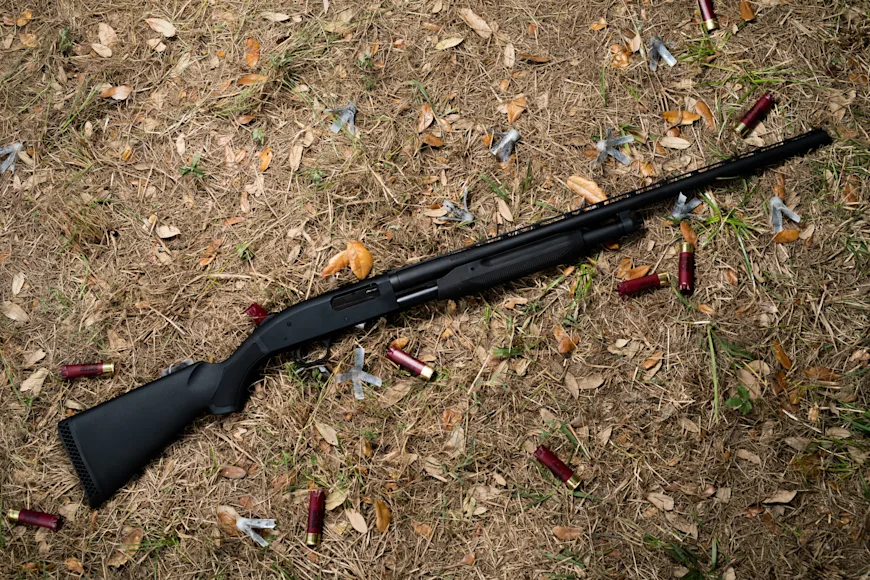We may earn revenue from the products available on this page and participate in affiliate programs. Learn more ›
Founded in 1919, in North Haven, Connecticult, O.F. Mossberg made its name building rimfire rifles. Although the company offered some bolt-action shotguns, in 1960, it made a bold decision. It changed course completely, discontinuing its rimfire lines and introducing a shotgun that would become one of America’s most popular firearms. The Mossberg Model 500 pump shotgun, is, for the money, one of the best duck hunting shotguns you can buy. It’s also the best deer hunting shotguns. And one of the best turkey guns. A versatile platform available in many variations and with many extra barrels and other parts made for it, a Model 500 hunting gun can become a Mossberg 500 home defense or Mossberg 500 tactical shotgun in a few minutes. In the past, Mossberg has billed the gun as “Shooting System” and it definitely lives up to that name.
The Mossberg 500 Hunting
Key Features
Gauge: 12
Chamber: 3-inch
Length: 47.5 inches
LOP: 14 inches
Trigger weight: 6.8 pounds
Overall weight: 6.5 pounds
The Mossberg 500 Hunting

The Mossberg 500—America’s Do-It-All Shotgun
After World War II, American hunters wanted firepower, and the double guns of the pre-war period were eclipsed in popularity by semiautomatic and pump shotguns. Having seen Remington’s success with the Remington 870 Express, Mossberg went to work on a pump shotgun of its own. Like the 870, it would be an inexpensive gun that took advantage of innovations in manufacturing and materials developed by gunmakers during WWII. It made use of stamped parts and an alloy receiver that was not only less expensive to make than a steel receiver, but also very lightweight. It was made to compete with the 870 in price or even undercut it a little.
Read Next: Mossberg 500 vs. Remington 870
Available in 12 and 20 gauge and .410, the Model 500 is chambered for 3-inch shells. It makes a very capable, very reliable, waterfowl gun. The first Model 500s had only a single action bar connecting the slide and the bolt. Once Remington’s patent on dual-action bars expired, Mossberg added a second bar to make the gun work more smoothly and more reliably. The guns have gone on to serve with police departments and the military, which is a testament to their reliability. While Mossberg 500s are the first shotgun of many hunters, a lot of experienced waterfowlers keep a Mossberg 500 12 gauge on hand as a bad-weather and backup gun. Also, with its top safety it’s a gun that left and right handers can both shoot easily, making it a good choice for left handers and good as a loaner gun, too.
How We Tested the Mossberg 500
The Model 500 was one of four pump guns we took on our test for the best duck hunting shotguns during teal season at Pintail Hunting Club. We shot it at ducks in the mornings and on clays in the afternoons. All of us enjoyed the chance to shoot pumps again. These days I only use pumps for turkey hunting, and it was fun to remember how to work the slide quickly in between doubles and triples.

Mossberg 500 Hunting pattern at 35 yards Stephen Maturen
A Light Gun…That Kicks
Besides the shooting sessions at feathered and clay targets, we weighed and measured the gun and checked its trigger pul. Also, we made it part of a marathon patterning session under the hot Texas sun. At just 6.5 pounds, the Model 500 was by far the lightest of the pump guns we tested. At 6.8 pounds, the trigger pull outweighed the gun, which is never good, but it was not unshootable. We tested it with Federal Top Gun Target Loads and Remington Gun Clubs. We patterned it with Federal Speed-Shok
1 ¼ ounce loads of steel. In the field, we shot the Speed Shok and HeviShot HeviHammer blended loads. The gun patterned very well with the included factory Modified choke.
Model 500s have always been slick guns out of the box. This is perhaps because their design borrows elements from the old, forgotten classic Remington Model 31 pump, once nicknamed The Ball Bearing Repeater for its smoothness. We found it to be a lot of fun to shoot for that reason. Although as a lightweight gun, it also lets you feel the recoil. And the simple rubber buttpad didn’t do much to cut the kick, either.
Also, the plastic top safety was stiff. This was not a problem when we were shooting at clays and could leave it off—but definitely a sticking point, so to speak, in the field where we needed to get the gun into action quickly. Teal don’t always give you a chance to get ready. You can work the safety back and forth while sitting at home and watching TV, but it’s easier and quite inexpensive to spend $20 or so on one of the many tactical safeties available for the Model 500 and do your own installation. One of the beauties of the Mossberg Model 500 is that you can find all kinds of aftermarket parts for it because it is so popular.
Methodology: How We Judged the Mossberg 500
Handling and Ergonomics
The Model 500 is light, a trait a lot of people like these days. But that does come with a cost in increased recoil, especially when you shoot heavy 3-inch duck loads. The operation was very slick and it was fun to shoot at targets. We did find the safety to be on the stiff side.
Workmanship and Aesthetics
We tested a black synthetic stocked model with a matte metal finish. So, “workmanship” doesn’t apply in the traditional gun-making sense of the word. That said, the lines and molded checkering of the synthetic stock and forend look good. The gun is solidly put together and the action is slick out of the box. Mossberg has put millions of these guns together, and that experience is evident in the finished product.
Versatility
From the very beginning, back in 1960, Mossberg billed the Model 500 as one gun that can do it all. It has only grown more versatile since. In the 1980s, it was one of the first guns available with rifled slug barrels. You can buy extra barrels, interchangeable chokes, and stocks and other accessories as well as aftermarket parts. You can easily convert a Mossberg 500 waterfowl gun into a tactical model.
Reliability
Mossbergs are reliable guns. The military uses them because they are reliable, and because they have meet the Mil-Spec 3443E requirement, which includes a 3,000-round buckshot test in which the gun cannot suffer breakage nor more than three malfunctions. Our own test, which involved three days at the edge of shallow wetlands plus target shooting, was no problem for the Model 500, which never suffered a single malfunction.
Value
The Model 500 was introduced as a value gun way back in 1960, and it’s still a great value today. Listing for $459, it’s the most gun for the least money that you’ll find anywhere, a versatile platform that can be converted to any purpose. It functions reliably and is a proven design, both in the field and in combat.

Limits of Texas teal piled up during our duck gun test at Pintail Hunting Club. Stephen Maturen
What the Mossberg 500 Does Best
The Mossberg 500 is a great value. It’s inexpensive, it works, and with accessories and extra barrels and chokes it can be tailored to do anything you need a shotgun to do, from dropping a duck to smashing a clay to defending your home. Or if there is a special purpose you need to fill, there is probably a Mossberg 500 made for the task. And there is a Mossberg 500 combo that comes with smoothbore bird barrel and rifled deer barrel. The top safety makes it a good choice for left-handers, too.
What the Mossberg 500 Does Worst
You can’t change the laws of physics. Shoot heavy shells in a light gun, and you will feel the recoil, especially if it is a fixed-breech gun like a pump shotgun. The Mossberg Model 500 12 gauge—and even the very light Mossberg Model 500 20 gauge—can kick, and the factory recoil pads don’t help cut the kick much. We found the trigger to be heavy, as well, which bothers some shooters quite a bit and others, like me, not at all. The sticky safety may loosen up over time, or it can easily be fixed with an aftermarket part. I have never liked the integral magazine cap in the Model 500’s barrel ring which can be sticky to unscrew. On the other hand, you’ll never lose it, so there’s that.
Final Thoughts on the Mossberg 500
The Mossberg 500 is an unlikely classic. Mossberg gambled on the gun in 1960, putting all their eggs in the 500 basket as they focused on making the new budget pump shotgun. They succeeded beyond their wildest dreams with an enduring design that just passed its 61st birthday with no sign of slowing down. The Mossberg Model 500 makes a solid, dependable, affordable choice just as much today as it did in 1960. We found it to be an easy gun to shoot and very reliable.
In fact, the Model 500 and the slightly more expensive, heavier Remington 870 were nearly tied on our waterfowl gun test scorecards until we settled on a category winner after shooting the two guns head to head at clays. Aside from a heavy trigger that you may never notice, it’s a good shooter and a versatile shotgun and one you can always find a use for, no matter how many hunting shotguns you own.






